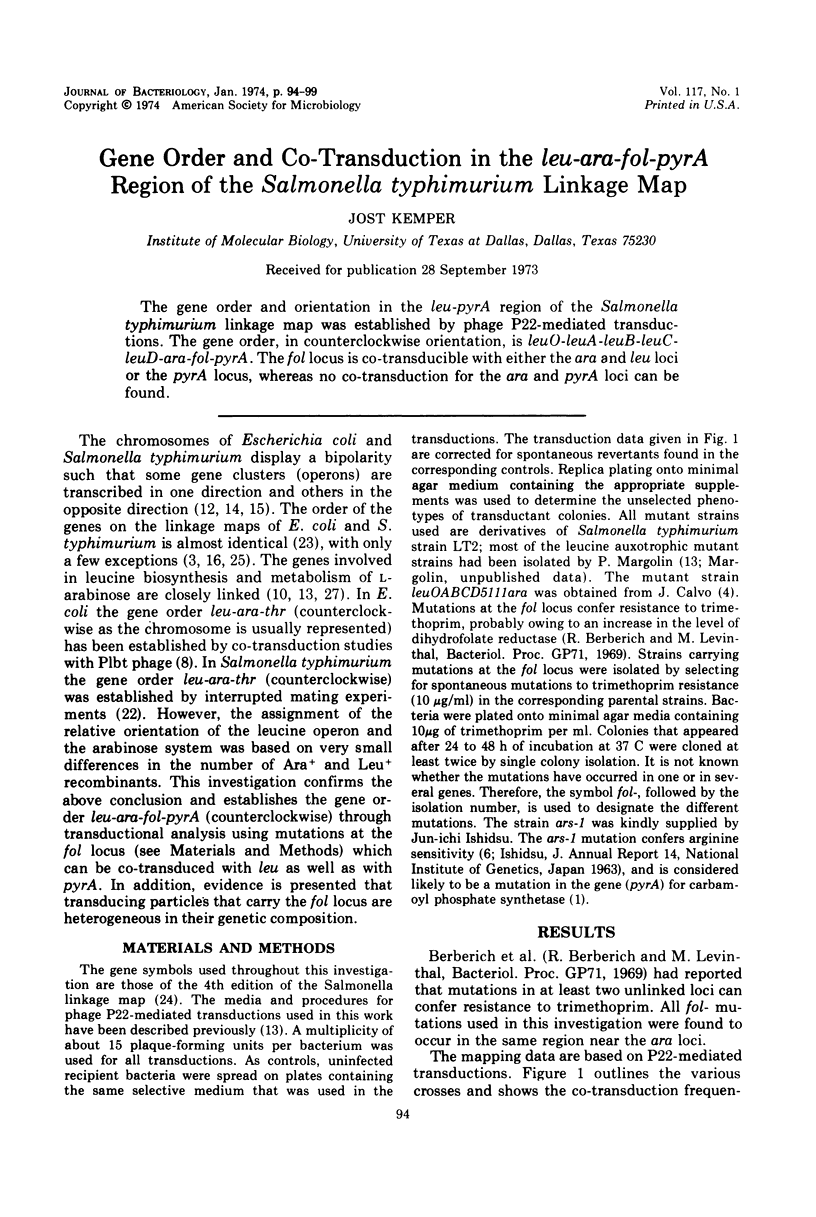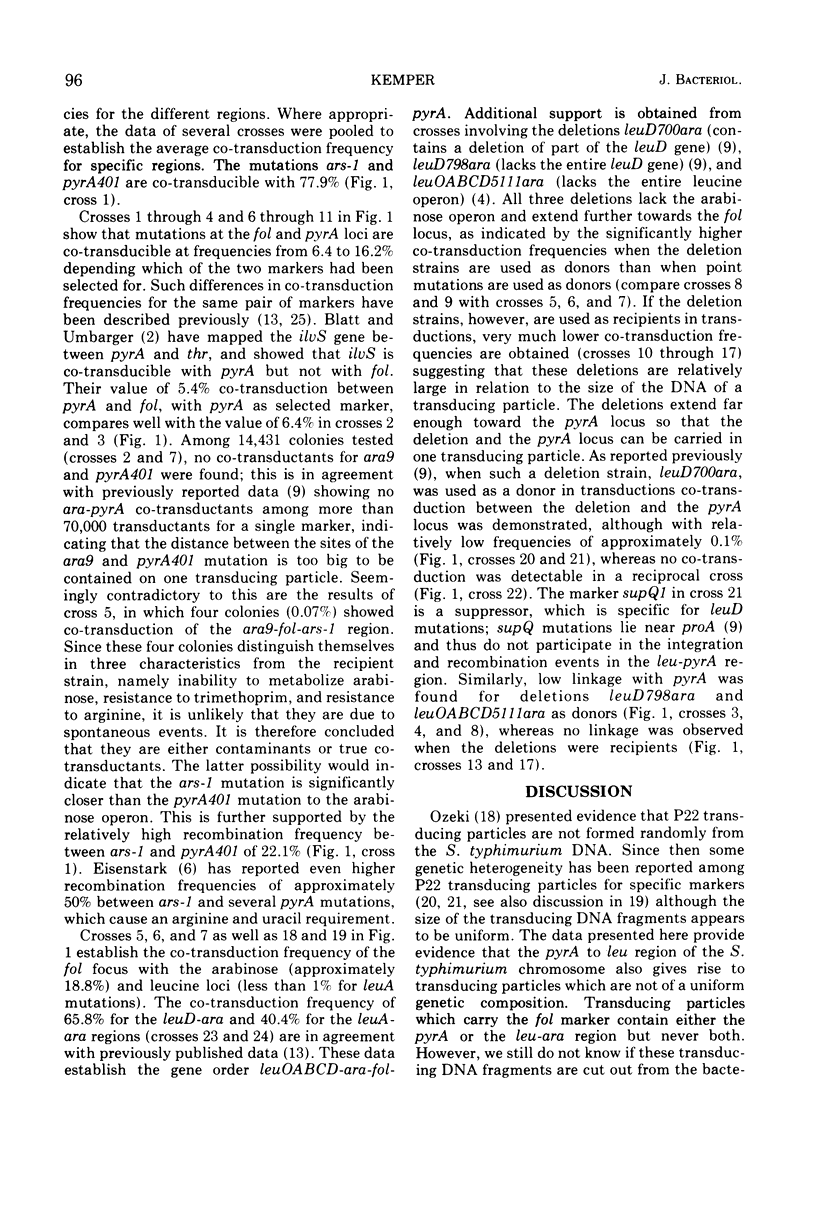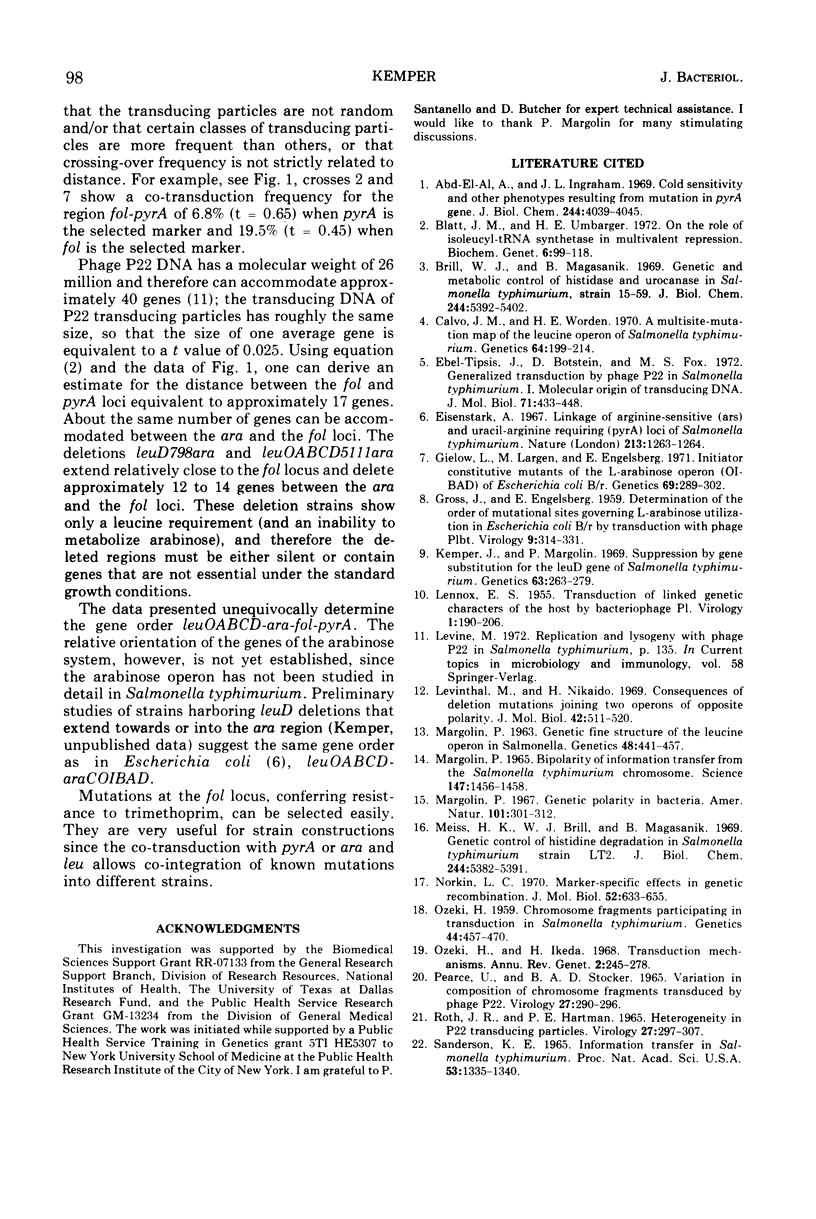Abstract
The gene order and orientation in the leu-pyrA region of the Salmonella typhimurium linkage map was established by phage P22-mediated transductions. The gene order, in counterclockwise orientation, is leuO-leuA-leuB-leuC-leuD-ara-fol-pyrA. The fol locus is co-transducible with either the ara and leu loci or the pyrA locus, whereas no co-transduction for the ara and pyrA loci can be found.
Full text
PDF





Selected References
These references are in PubMed. This may not be the complete list of references from this article.
- Abd-el-Al A., Ingraham J. L. Cold sensitivity and other phenotypes resulting from mutation in pyrA gene. J Biol Chem. 1969 Aug 10;244(15):4039–4045. [PubMed] [Google Scholar]
- Blatt J. M., Umbarger H. E. On the role of isoleucyl-tRNA synthetase in multivalent repression. Biochem Genet. 1972 Apr;6(2):99–118. doi: 10.1007/BF00486395. [DOI] [PubMed] [Google Scholar]
- Brill W. J., Magasanik B. Genetic and metabolic control of histidase and urocanase in Salmonella typhimurium, strain 15-59. J Biol Chem. 1969 Oct 10;244(19):5392–5402. [PubMed] [Google Scholar]
- Calvo J. M., Worden H. E. A multisite-mutation map of the leucine operon of Salmonella typhimurium. Genetics. 1970 Feb;64(2):199–214. doi: 10.1093/genetics/64.2.199. [DOI] [PMC free article] [PubMed] [Google Scholar]
- Ebel-Tsipis J., Botstein D., Fox M. S. Generalized transduction by phage P22 in Salmonella typhimurium. I. Molecular origin of transducing DNA. J Mol Biol. 1972 Nov 14;71(2):433–448. doi: 10.1016/0022-2836(72)90361-0. [DOI] [PubMed] [Google Scholar]
- GROSS J., ENGLESBERG E. Determination of the order of mutational sites governing L-arabinose utilization in Escherichia coli B/r bv transduction with phage Plbt. Virology. 1959 Nov;9:314–331. doi: 10.1016/0042-6822(59)90125-4. [DOI] [PubMed] [Google Scholar]
- Gielow L., Largen M., Englesberg E. Initiator constitutive mutants of the L-arabinose operon (OIBAD) of Escherichia coli B/r. Genetics. 1971 Nov;69(3):289–302. doi: 10.1093/genetics/69.3.289. [DOI] [PMC free article] [PubMed] [Google Scholar]
- Kemper J., Margolin P. Suppression by gene substitution for the leuD gene of Salmonella typhimurium. Genetics. 1969 Oct;63(2):263–279. doi: 10.1093/genetics/63.2.263. [DOI] [PMC free article] [PubMed] [Google Scholar]
- LENNOX E. S. Transduction of linked genetic characters of the host by bacteriophage P1. Virology. 1955 Jul;1(2):190–206. doi: 10.1016/0042-6822(55)90016-7. [DOI] [PubMed] [Google Scholar]
- Levine M. Replication and lysogeny with phage P22 in Salmonella typhimurium. Curr Top Microbiol Immunol. 1972;58:135–156. doi: 10.1007/978-3-642-65357-5_4. [DOI] [PubMed] [Google Scholar]
- Levinthal M., Nikaido H. Consequences of deletion mutations joining two operons of opposite polarity. J Mol Biol. 1969 Jun 28;42(3):511–520. doi: 10.1016/0022-2836(69)90239-3. [DOI] [PubMed] [Google Scholar]
- MARGOLIN P. BIPOLARITY OF INFORMATION TRANSFER FROM THE SALMONELLA TYPHIMURIUM CHROMOSOME. Science. 1965 Mar 19;147(3664):1456–1458. doi: 10.1126/science.147.3664.1456. [DOI] [PubMed] [Google Scholar]
- MARGOLIN P. Genetic fine structure of the leucine operon in Salmonella. Genetics. 1963 Mar;48:441–457. doi: 10.1093/genetics/48.3.441. [DOI] [PMC free article] [PubMed] [Google Scholar]
- Meiss H. K., Brill W. J., Magasanik B. Genetic control of histidine degradation in Salmonella typhimurium, strain LT-2. J Biol Chem. 1969 Oct 10;244(19):5382–5391. [PubMed] [Google Scholar]
- Norkin L. C. Marker-specific effects in genetic recombination. J Mol Biol. 1970 Aug;51(3):633–655. doi: 10.1016/0022-2836(70)90013-6. [DOI] [PubMed] [Google Scholar]
- Ozeki H. Chromosome Fragments Participating in Transduction in Salmonella Typhimurium. Genetics. 1959 May;44(3):457–470. doi: 10.1093/genetics/44.3.457. [DOI] [PMC free article] [PubMed] [Google Scholar]
- Pearce U., Stocker B. A. Variation in composition of chromosome fragments transduced by phage P22. Virology. 1965 Nov;27(3):290–296. doi: 10.1016/0042-6822(65)90108-x. [DOI] [PubMed] [Google Scholar]
- Roth J. R., Hartman P. E. Heterogeneity in P22 transducing particles. Virology. 1965 Nov;27(3):297–307. doi: 10.1016/0042-6822(65)90109-1. [DOI] [PubMed] [Google Scholar]
- Sanderson K. E. Genetics of the Enterobacteriaceae. A. Genetic homology in the Enterobacteriaceae. Adv Genet. 1971;16:35–51. doi: 10.1016/s0065-2660(08)60353-3. [DOI] [PubMed] [Google Scholar]
- Sanderson K. E., Hall C. A. F-prime factors of Salmonella typhimurium and an inversion between S. typhimurium and Escherichia coli. Genetics. 1970 Feb;64(2):215–228. doi: 10.1093/genetics/64.2.215. [DOI] [PMC free article] [PubMed] [Google Scholar]
- Sanderson K. E. Information transfer in Salmonella typhimurium. Proc Natl Acad Sci U S A. 1965 Jun;53(6):1335–1340. doi: 10.1073/pnas.53.6.1335. [DOI] [PMC free article] [PubMed] [Google Scholar]
- Sanderson K. E. Linkage map of Salmonella typhimurium, edition IV. Bacteriol Rev. 1972 Dec;36(4):558–586. doi: 10.1128/br.36.4.558-586.1972. [DOI] [PMC free article] [PubMed] [Google Scholar]
- Schmieger H. The molecular structure of the transducing particles of Salmonella phage P22. II. Density gradient analysis of DNA. Mol Gen Genet. 1970;109(4):323–337. doi: 10.1007/BF00267702. [DOI] [PubMed] [Google Scholar]
- Somers J. M., Amzallag A., Middleton R. B. Genetic fine structure of the leucine operon of Escherichia coli K-12. J Bacteriol. 1973 Mar;113(3):1268–1272. doi: 10.1128/jb.113.3.1268-1272.1973. [DOI] [PMC free article] [PubMed] [Google Scholar]
- Wu T. T. A model for three-point analysis of random general transduction. Genetics. 1966 Aug;54(2):405–410. doi: 10.1093/genetics/54.2.405. [DOI] [PMC free article] [PubMed] [Google Scholar]


